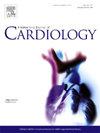肥厚性心肌病的家庭筛查:基因型阳性表型阴性个体的初始心脏病学评估和长期随访。
IF 3.2
2区 医学
Q2 CARDIAC & CARDIOVASCULAR SYSTEMS
引用次数: 0
摘要
目的:(i)通过家族级联检测在亲属中检测到致病性/可能致病性(P/LP)基因变异的个体中调查肥厚性心肌病(HCM)的患病率,(ii)在随访期间评估基因型阳性表型阴性(G+/P-)个体的表型进展。结果:从2000年到2023年,273名个体在通过家庭筛查检测P/LP变异后接受了心脏病学评估。经初步评估,128人(47 %)被诊断为HCM。与145名 G+/P-患者相比,HCM患者年龄更大(48 vs 38 岁,P )。结论:初步评估是高产率的,47 %的G+患者被诊断为HCM,更常见于老年男性。在中位8年的随访中,6% %的G+/P-个体发展为轻度HCM,无不良心脏结局。这些数据支持在所有一级亲属中进行初始筛查,但此后对G+/P-个体进行(非常)低频率的心脏病学评估。本文章由计算机程序翻译,如有差异,请以英文原文为准。
Family screening for hypertrophic cardiomyopathy: Initial cardiologic assessment, and long-term follow-up of genotype-positive phenotype-negative individuals
Aims
(i) Investigate the prevalence of hypertrophic cardiomyopathy (HCM) in individuals with pathogenic/likely pathogenic (P/LP) gene variants detected through family cascade testing in relatives, and (ii) evaluate phenotypic progression in genotype-positive phenotype-negative (G+/P-) individuals during follow-up.
Results
From 2000 to 2023, 273 individuals underwent cardiologic evaluation following P/LP variant detection through family screening. Upon initial evaluation, HCM was diagnosed in 128 (47 %) individuals. Comparing with 145 G+/P- individuals, HCM patients were older (48 vs 38 years, p < 0.001) and more likely male (57 % vs 34 %, p < 0.001). During follow-up (median 11 years), 14 (11 %) of the HCM patients died (two from sudden cardiac death), four (3 %) underwent myectomy, 15 (12 %) developed atrial fibrillation and 17 (13 %) required implantable cardioverter-defibrillator implantation (15 primary prevention, 88 %). HCM-related adverse outcomes correlated with younger diagnosis age.
During follow-up (median 8 years) of 118 (out of 145) G+/P- subjects with at least one year of follow-up, seven (6 %) individuals (71 % female, diagnosed age 39–77, after median follow-up 6 years) developed HCM (mean maximal wall thickness increasing from 10.2 mm to 13.3 mm). In this G+/P- cohort, significant echocardiographic changes from baseline to last visit were negligible. Over half (56 %) had <1 mm change of maximal wall thickness. No adverse cardiac outcomes occurred.
Conclusion
The initial evaluation was high-yield, with HCM being diagnosed in 47 % of G+ individuals, more frequently in older males. Over a median 8-year follow-up, 6 % of G+/P- individuals developed mild HCM, with no adverse cardiac outcomes. These data support initial screening in all first degree relatives, but (very) low-frequency cardiologic evaluations for G+/P- individuals thereafter.
求助全文
通过发布文献求助,成功后即可免费获取论文全文。
去求助
来源期刊

International journal of cardiology
医学-心血管系统
CiteScore
6.80
自引率
5.70%
发文量
758
审稿时长
44 days
期刊介绍:
The International Journal of Cardiology is devoted to cardiology in the broadest sense. Both basic research and clinical papers can be submitted. The journal serves the interest of both practicing clinicians and researchers.
In addition to original papers, we are launching a range of new manuscript types, including Consensus and Position Papers, Systematic Reviews, Meta-analyses, and Short communications. Case reports are no longer acceptable. Controversial techniques, issues on health policy and social medicine are discussed and serve as useful tools for encouraging debate.
 求助内容:
求助内容: 应助结果提醒方式:
应助结果提醒方式:


